
The majority of us spend about one-third of our day sleeping. We all somewhat know that sleep is important, let’s not hammer that home. Instead, let’s go more in-depth into why sleep is essential for personal productivity.
We talk a lot about this in our product Better Sleep why sleep is crucial for your productivity. In short, sleep is essential for balancing your energy levels. In the book The Power of Full Engagement (review), Tony Schwartz talks about four different levels of energy. The premise of the book is that we shouldn’t worry about managing our time, but managing our energy. This discussion is not the focus on this post, but the concepts of the book are very interesting. In the book the four different levels are ordered in a pyramid and each energy source has an important role for personal productivity.
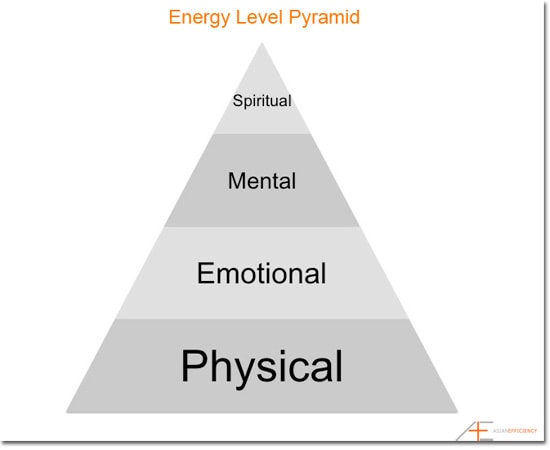
The order of the levels is important too, with physical energy at the bottom and spiritual energy at the top. A pyramid relies on its foundation to support the rest (just like any other building) and that is exactly how you should look at peak productivity. In this article we will take a closer look at the physical level, where sleep plays an important role.
Physical energy is the fundamental source of fuel, even if your work is mostly sedentary (i.e., you sit in an office chair all day). The physical level is all about managing your body. Look at it this way: if you are tired there is no way you will get work done. You are also more likely to procrastinate when you’re tired and your focus will likely be non-existent. In essence, productivity goes out the window when you are physically exhausted.
Sleep plays a big role within the physical level (the other main factors are exercise and diet within the physical layer). In order to have your physical energy source at optimal level you need to have had enough sleep the night before. Thus, the idea of being optimally productive requires some planning of your sleep. If you want to be productive tomorrow, you will need to ensure that tonight you will get enough sleep which means getting in bed at a certain time. Especially when you need to be up before a specific time.
The average American gets about 6.7 hours of sleep, but the average person needs between 7 and 9 hours of sleep. This varies a lot person to person and it also changes based on your age, physical fitness, and gender. Pregnant women, teenagers, and people in their late 30s all need different amounts of sleep. Below is a table of number of hours of sleep each age bracket on average requires.
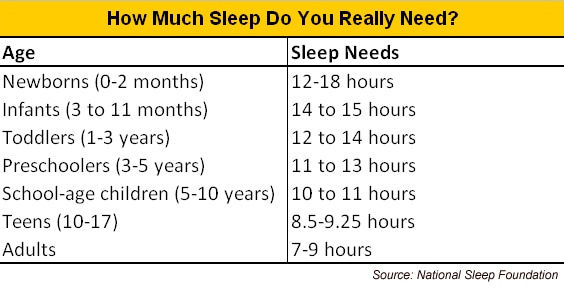
How Much Sleep Do You Need?
According to the table I would need over 7+ hours of sleep each night. I did some tracking myself on how much sleep I actually get when I sleep when I don’t set an alarm clock. With the use of Toggl on my iPhone, I would start a timer every night before going to sleep, and not use an alarm clock to wake myself up. That way I would naturally wake up when my body was ready. I closed my blinds and my bedroom was as dark as possible, so sunlight was no factor.
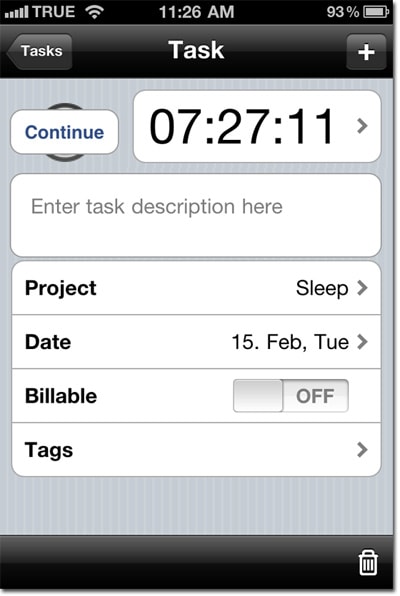
Below is a graph of my hours of sleep for a week.
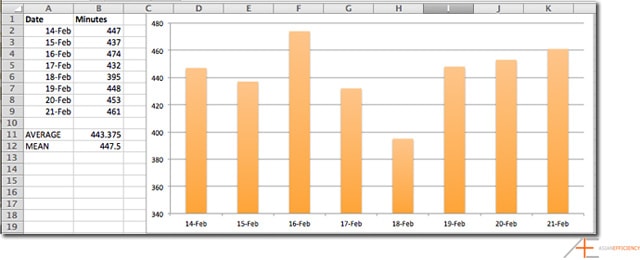
Below is fellow Asian Efficiency blogger Aaron’s graph for the same week.
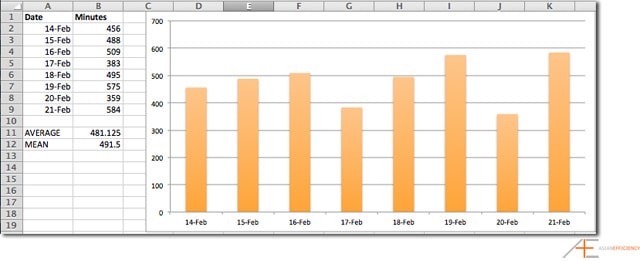
Once you know how much sleep you need, that is when you can start planning your sleeping schedule. This is really important to know in order to set yourself up for a good day. I’m sure you have had days when you woken up and just wanted to go back to sleep. Or when the alarm clock wakes you up and you feel like an angry Incredible Hulk. These things can all be prevented by knowing how much sleep you need and understanding your own sleeping schedule.
Let’s say you have a 9-5 job and you need 7.5 hours of sleep. At what time you need to be asleep? This will depend on different activities in the morning:
- breakfast
- bathroom / shower
- commute to work
Just to mention a few. You need to know how much time your morning rituals take. Let’s say your morning ritual and commute takes about 1.5 hours. That would mean then that you need to wake up at 7:30am (9 minus 1.5). Knowing you need to sleep 7.5 hours of sleep, you need to be asleep by midnight. That means laying in bed with your eyes closed at midnight.
Now you do want to give yourself a little buffer before falling asleep and perhaps do things that will make you fall asleep. Tim Ferriss talks a little bit about sleep in his book The 4 Hour-Body. He did a lot of testing on how to fall asleep. After testing these myself, I can recommend you these tips too (and the book). Below are some of his and my own personal tips.
- Set the room temperature to 67-70F (19-22C).
- Take a cold shower before bed.
- Read a book / magazine.
- Dim the lights in your room (best if you have a dimmer).
- Do not use your computer before sleeping.
Sleep Debt
When you don’t get enough sleep, you start to accumulate sleep debt. If you know that you need 7.5 hours but you only got 6 hours of sleep, that means you have a sleep debt of 1.5 hours. It’s important to understand that sleep debt accumulates over time and your body wants it to be at zero. Having no slept debt means you are getting the number of hours of sleep you need.
Your body will naturally try to keep your sleep debt as close to zero as possible. This explains why a lot of people sleep in on the weekends, because their body wants to catch up with the sleep debt. Or when you go on vacation to a different part of the world, you might be lacking on sleep because of the traveling so you catch up on it the first week of vacation where you sleep a lot.
Research has shown that lack of sleep also drops your productivity. When you haven’t gotten enough sleep, your brain functions poorly. This takes place already after one night of lack of sleep. It accumulates as each day of lack of sleep continues. Even small amounts of sleep debt have a significant impact strength, cardio capacity, mood and overall energy levels. Some fifty studies have shown that mental performance all decline steadily as sleep debt increases.
In my week of tracking, you can see that I didn’t get enough sleep on February 18th (only 395 minutes, far from my average of 443 minutes). From tracking my time for other activities that day, it turned out I also was the least productive that morning and afternoon. I didn’t get as much work done as I set out the night before.
Now what do you do when you had a lack of sleep? Simple. You catch up on it as soon as possible. We can still counter it artificially with caffeine, sunlight, and other stimulants, but they act like band-aids. You want to fix the root of the issue as soon as possible and fortunately there is a simple solution for this: naps. So with the example above, if you only got 6 hours of sleep you want to take a nap of 1.5 hours to catch up. In my case on February 18th, I missed about 50 minutes of sleep. Guess what I did to address this sleep debt? I took an hour and a half nap. The reason for the 90 minute naps is that our sleep cycles runs about per 90 minutes. For you math wizards, I’m sure you have noticed that 7.5 hours is a multiple of 90 minutes!
Naps
For some people naps in the afternoon might not be viable, especially if you work in an office. The best alternative then is to take little naps or power naps as some people call them. Naps represent a form of strategic recovery to catchup with your sleep debt. According to multiple studies by the NASA Fatigue Counter Measures Program, naps help boost productivity and mental performance.
In the book Brain Rules (review) the author explains how we are are hard wired to have a dip in alertness in the mid-afternoon. Our natural rhythms are then at their lowest which is the best time to take a nap and the author calls it the “nap zone.”
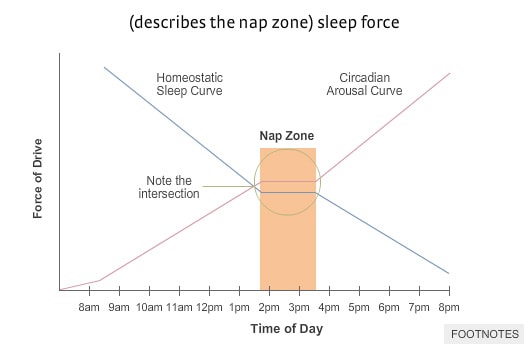
This phenomena is known as a siesta, the mid-afternoon nap that is not-so-common among the majority of Western countries but a tradition among others such as Spain, Latin America and a lot of Asian countries. It takes a little practice to nap in the afternoon but from our experience it does boost your mental performance, increases your focus, and address the fatigue feeling you might have of a bad night of sleep. This is especially for you readers who do not work in an office and have the flexibility to set their own hours. If you can’t fall asleep in the afternoon here are some tips.
- Buy a sleeping mask (I use this one).
- Be in isolation and preferably a dark room.
- Lay down if possible.
- Optional: use ear plugs (my sleeping mask came with them).
For quick naps, set your alarm clock to no longer than 25 minutes. Most people can take a nap between 15-25 minutes before they hit the deep sleep phase. It’s important to wake before your hit deep sleep or else you wake up feeling tired. When you need longer naps to catch up on the lack of sleep of the previous night, adhere to the 90 minute cycle. So either nap for 90 minutes or 3 hours.
Next Actions
- Start tracking each night how much sleep you need.
- Track this data for a week for consecutive days.
- Figure out your sleeping schedule.
To achieve personal productivity it is important to understand the importance of sleep. The best way to start your day is by having a good night of sleep. In case you need miss out on sleep, try to catch up on it as soon as possible with a nap and your next night of sleep. If you are having trouble getting the sleep you need, check out our product Better Sleep.
If you want to start tracking your hours of sleep, you can use Toggl like I did on my iPhone. Here are the steps to get you started on this.
1. Get Toggl for your iphone here (free).
2. Register an account on Toggl.com.
3. On your iPhone, launch the Toggl app.
4. Create a new task by pressing the PLUS button on the rop right corner.
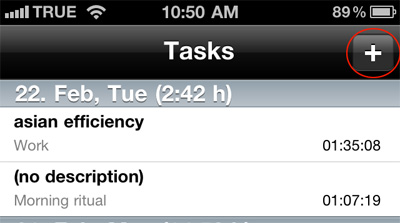
5. Since this is your first time, you first need to create a new project. Press on the project field.
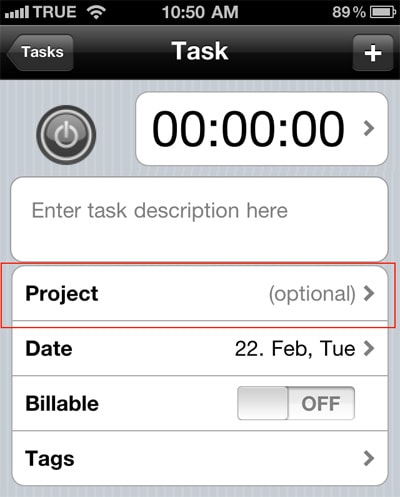
6. On the top right corner, press on the PLUS button to create a new project in Toggl.
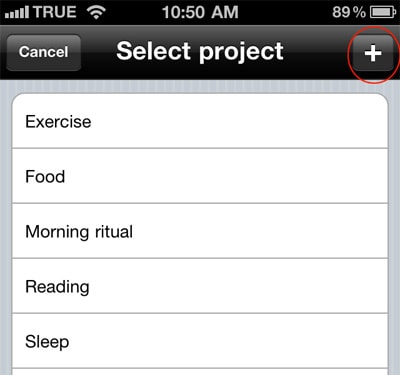
7. Type in “Sleep” as your project name and press on the “Done” button.
8. Select your Sleep project.
9. Press on the gray button to start your timer.
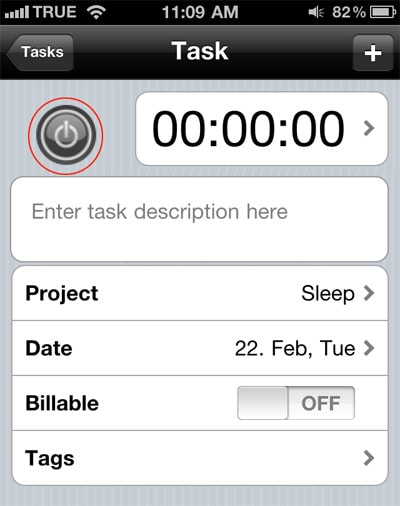
10. Press the button again to stop the timer when you wake up.
All your tracking data will also be available on Toggl.com with graphs and more statistics.
Photo by: george.schon

Great advice-if you work mon-fri, 9,5.
Any help for those working 24/7 rosters?
On morning shifts I’m up at 3 am. Then after a few mornings I’m on afternoons, where I get to sleep in (without alarm) that morning, catching up on sleep debt with the consequence that I then stay up after work till 1-2 am. Couple days of this then a few days off and it all goes around again.
I asked everyone I could one morning at work, how much sleep they had before coming in for morning shift. Longest: 6 hours. Least (mine) 2.5 hours. Average was 4-5.
No cycles can be established when your wake time for your ‘day’ begins on several variations: I have three: 3 am, 11 am or 8 am. Can’t found any theory to work with this flexibility. When asked how I schedule for my day I respond which day? Am shift afternoons or days off.
Great article, with some really good pointers on getting enough and the right kind of sleep.
Thanks. :)
Productivity is definitely the key thing that counts for everyone’s life whether personal or business. There are ways one should always strive for productivity such as use of best strategies and apps that could help in increased efficiency.
I personally like and would recommend Replicon project time management software that is really an easy to use cloud based time tracking tool. Other tools such as Harvest are good enough but they do have certain issues such as downtime and speed etc.
There was a time that my productivity used to suffer because of the poor quality of the sleep I got. 2 things that I changed have I believe made me in to a better person. 1. performing 15 minutes of yoga before I sleep. 2. Visualizing my self achieving the tasks of tomorrow while I sleep. Because of these two changes I wake up full of energy and in the right mindset.
Best time tracking app I’ve found so far is Eternity: https://itunes.apple.com/us/app/eternity-time-log-personal/id296683442?mt=8 (no I don’t work for them, just my personal experience). Have used it flawlessly for a few years now and love it.
Allows me to log my time in numerous different categories and instantly get reports based on each activity (or category) for any day, week, and/or month.
Allows me to get reports on specific activities, like sleeping. But also allows me to get reports on “umbrella” categories of activities. For example, I track how many hours per week I spend “systemizing my business”, which is an umbrella category for a few different activities. Eternity allows for “hierarchies” of tasks and you can get a report at any level of any hierarchy.
If you haven’t already discovered Eternity, check it out. It’s been immensely useful for me for all variations of time tracking. Haven’t found any flaws or missing features over the last few years, although I’m far from perfect in time management, so maybe you guys will find weaknesses I haven’t.
Great blog guys, keep up the great work!
Tim :)
I don’t like bringing my laptop to the bedroom. I train my brain to be in work mode when I’m in my home office and use the computer there. But when I enter my bedroom, I subliminally know that it is the quiet zone and I should be sleeping there.
I also kicked my TV out of the bedroom. It was too hard to resist turning on the boob tube to see what was on ESPN, CNN, or check out some crazy post-midnight infomercial.
Once upon a time, my wife and I were hooked on the television show 24. I had bought the entire eight season DVD set. That was a big mistake! We were hooked and would only sleep for four hours before heading off to work. It was always “just one more episode, OK honey?”
After we finally finished all eight seasons, we knew we had to banish the TV from the bedroom forever!
I also make sure electronic devices such as the iPad is out of arm’s reach from the bed. It would be too tempting to pick up the iPad for a game of Angry Birds or whatever game of the week is.
Great article! You mentioned naps. I have been using Pzizz Energizer for a number of years – when it was a Mac app and then on the iPhone – to help me reset. I would definitely recommend it over other similar apps as Pzizz generates a new programme each time you listen to it, so your brain doesn’t get used to hearing the same messages over and over.
https://itunes.apple.com/us/app/pzizz-energizer/id326427471?mt=8
Although the app hasn’t been updated in a long while, it still works well and helps me switch off in the afternoon or early evening and when I wake I feel refreshed and ready for the next task.
Looks like a great and useful app – will definitely give this a try. Thanks for sharing Sailesh!
Thanh,
Great article!
I’m definitely looking forward to get my sleeping habits right. Right now we have a small baby in the house (turned just two months) and I can’t nearly as much sleep as I would love to :)
Cheers,
Timo
Heh I can imagine you must be sleeping very irregular and only 2 hours a night!
Do you guys have girlfriends? I am asking this, because my girl is waking up way before me, and since I have reallly light sleep, I wake up on the slightest notion of movement.
Now this will have impact on my cycles, so I am wondering how would you solve that issue.
Yep, I have this problem too. I’ve found that my body has learnt to automatically adjust – I’ll wake up a bit, then realise it’s just her, then I’ll go back to sleep. Even though I am also a super light sleeper I can drop back into sleep pretty quickly. I think the ability to fall asleep comes down to being able to properly manage your energy levels, with things like working out, diet and daily activity all factoring in.
I don’t think it’s possible to get “perfect” sleep so to speak. It’s more about doing the best we can and catching up on sleep on weekends or vacations.
Thanh, This is great thanks! You might want to check out the Sleep Cycle App for iPhone. You sleep with your phone and it tracks your movements thus signaling Deep sleep phases. I just started using it, and it provides some awesome info on your personal sleep cycles!
Hey Chris thanks for the app suggestion. It looks very interesting and I’m going to give it a test-drive. I’ve been tracking a lot of data lately for my sleep that I will at some point release on the blog too. I’ll use this app too and see what I can find and maybe I’ll post it on the blog too. Thanks again for the suggestion.
Where do you put your phone? I don’t like stuff that are emitting radio signals beside my head :/
I took your advice and downloaded the Toggl app and I am off and running a large number of projects that I want data on…thanks.
Awesome! Let us know what you discover. It will be interesting to see what the data really says instead what you normally think.